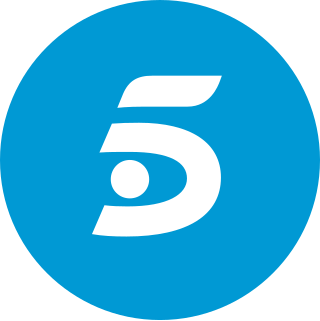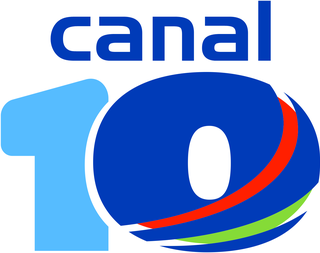
Digital Video Broadcasting (DVB) is a set of international open standards for digital television. DVB standards are maintained by the DVB Project, an international industry consortium, and are published by a Joint Technical Committee (JTC) of the European Telecommunications Standards Institute (ETSI), European Committee for Electrotechnical Standardization (CENELEC) and European Broadcasting Union (EBU).

Telecinco is a Spanish free-to-air television channel operated by Mediaset España. The channel was previously known as Tele 5, because it had first begun its experimental transmissions on 10 March 1989, and a year later, it was officially launched on 3 March, 1990, becoming the fifth of the national terrestrial television channels and the second private channel in Spain. In 1997, Tele 5 was rebranded as Telecinco, dropping the biscione-absent flower logo seen in other Mediaset channel logos.
Television is one of the major mass media of Chile. It was introduced in 1957.

Euskal Irrati Telebista is the Basque Autonomous Community's public broadcast service, which broadcasts throughout the Basque Country. Its main brand is Euskal Telebista.
Cuba was the first Latin American country to begin television testing in December 1946 when station CM-21P conducted an experimental multi-point live broadcast. The first regular commercial broadcasting began in October 1950 by the small radio station Union Radio, soon followed by other stations. The broadcasts featured sport, soap operas, news, cooking shows, and comedy. Censorship was imposed following the 1952 coup by Fulgencio Batista, and again by the government of the Cuban revolution after their victory in 1959.

Canal 2 is a Nicaraguan free-to-air television network owned by Televicentro de Nicaragua, S.A., owned by the Mexican media mogul Remigio Ángel González. In theory, the channel's sister channels are those of Grupo Ratensa, but in practice, the channel is an independent operation with support from the Nicaraguan government.

Canal 10 is a nationwide terrestrial television channel from Nicaragua owned by Radio y Televisión de Nicaragua, S.A. (RATENSA), a company founded by Mexican investors.

Canal 4 is a state-run nationwide terrestrial television channel in Nicaragua owned by Informativos de Televisión y Radio S.A. (Intrasa), a company owned by two sons of Nicaraguan President Daniel Ortega, Carlos Enrique "Tino" Ortega and his brother Daniel Edmundo. Until 2007, Remigio Ángel González of Albavisión owned 94% of the channel's assets, after that, the Ortega-Murillo family regained control.
Telenica is a nationwide state-run terrestrial television channel from Nicaragua, founded by Nicaraguan businessman Carlos Briceño in 1992. The channel was bought by Juan Carlos Ortega Murillo in late 2009, yet it was not made public until January 2010, the change in ownership led to a change in profile. TN8 is one of Nicaragua's main channels.

Television is one of the major mass media of Argentina. As of 2019, household ownership of television sets in the country is 99%, with the majority of households usually having two sets. Cable television has become the most used type of delivering, with 73.2% of households having a cable provider.
Television in Spain was introduced in 1956, when the national state-owned public service television broadcaster Televisión Española (TVE) started regular analog free-to-air terrestrial black and white broadcasts. Colour transmissions started in 1972 after two years of test transmissions, with all programming transmitted in color in 1977, and colour commercials starting in 1978. TVE held a monopoly on television broadcasting until regional public channels were launched during the 1980s and commercial television started nationwide in 1990. Digital terrestrial television was launched on 30 November 2005 with analog service discontinued on 3 April 2010. Currently, television is one of the leading mass media of the country, and by 2008 was in 99.7% of households in Spain according to INE statistics.

Telenorte is a Chilean Television brand, launched as a TV network in 1966, closed in 2001 and relaunched through streaming since the 2010s. The network had stations in Arica, Iquique, Antofagasta and La Serena.
TV Red is a nationwide terrestrial television channel from Nicaragua owned by Ángel González. TV Red began broadcasting in August 2010, up until then channel 11 on Claro TV was occupied by VosTV.
Television in Peru has a history of more than 60 years. There are 105 television broadcasters in Peru, 22 of which are in Lima. In regard to television receivers, in 2003 there were 5,470,000 — that is 200 televisions for every thousand inhabitants. The number of cable subscribers was 967,943 in 2011.
Canal 15 was a Nicaraguan cable TV channel broadcasting from the city of Managua and founded by the local journalist Miguel Mora Barberena and his wife Verónica Chavez.
Canal 9 is a Nicaraguan terrestrial television channel broadcasting since 2011 from the city of Managua and owned by Digital Media de Nicaragua S.A., itself a part of the larger Grupo RATENSA.
Canal 6 is a Nicaraguan terrestrial television channel broadcasting from the city of Managua. The station claims to be owned by the Government of Nicaragua, but is actually owned by a joint stock company called NEPISA
Television in Nicaragua has a history of more than fifty years. Canal 8, the first terrestrial television channel in the country, started broadcasting on July 15, 1956. Currently there are more than 15 national terrestrial and cable TV channels.
Mega is a Spanish television channel owned by Atresmedia. Its programming is aimed towards a male audience.
Grupo Ratensa is the Nicaraguan subsidiary of Albavisión, a Latin American media company owned by Guatemalan-Mexican-American businessman Remigio Ángel González. The company operates three core television channels - channels 9, 10 and 11, formerly having interests on channel 4 which González had set up with local Sandinist partners. In addition, Ratensa operates a network of radio stations. It claims to be "the most complete media network and the network with the most reach in national television".







